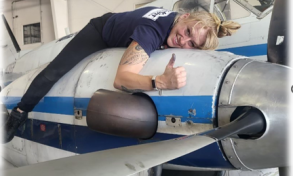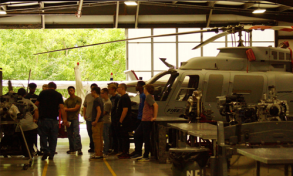When you first think of careers in aviation, you most likely think of the ones you see when you fly somewhere on a trip. You see pilots walking through the airport in their uniforms or once you board your flight. You are greeted by the flight attendant when you first board the plane or while they are serving refreshments during the flight. A glimpse out of the window during either take off or landing, will often reveal the air traffic control tower in the distance. These are just three of the many aviation jobs you will see if you ever take an airplane to your next business or vacation destination.
However, there are many aviation careers that passengers do not even know exist. Because these jobs are happening behind the scenes, most people do not even know they are taking place. From jobs within the airport to out in the hangers, there are hundreds of people ensuring your travel experience is seamless and as safe as possible. Not only are there people who inspect aircraft as they are being built, there are teams of engineers and technicians inspecting aircraft everyday.
Airline and Commercial Pilot
Pilots tend to be the poster children for the aviation industry. They are the ones that are the most visibly recognized and tend to be the ones you hear about the most. There is an extensive list of requirements you must fulfill to become a commercial pilot. Major airlines require a bachelor’s degree or the equivalent and for you to be deemed physically and mentally fit. To actually get your commercial pilot’s license, you must first have your private pilot’s license. You must also have at least 250 hours of flight experience and there are both written and flight exams you must pass, usually in a two year period. But that’s just for your commercial pilot’s license. To actually be hired by a major airline, you will need a minimum of 1,500 flight hours. This is known as the 1,500 rule, which came into effect in 2013 by the FAA.
Flight Attendant
The most visible aviation job is definitely that of a flight attendant. Although you most often see them serving drinks and refreshments during flights, their responsibilities extend far beyond this. Because they have the most contact with the passengers, almost all of a flight attendant’s duties are safety related. Not only do they conduct the safety demonstrations before takeoff, but flight attendants also conduct regular safety checks and listen for unusual noises during flight. Most airlines require applicants to have a high school degree or GED. They must have excellent customer service skills and conduct weeks of training once hired. Flight attendants that work on aircraft that have more than 20 seats must be certified by the FAA.
Air Traffic Controller
Although all you ever see of air traffic controllers is their tower, their main job is ensuring your safety. Air traffic controllers coordinate the movements of aircraft in and out of airports, ensuring there is a safe distance between them. They are the ones that give aircraft clearance to take off or land safely, and must inform aircraft of any changes to their flight patterns. To apply to become an air traffic controller, you must have some sort of formal education or employment with a minimum of three years of experience. There is an Air Traffic Collegiate Training Initiative program and assessments you must pass before being considered for an FAA training program. Gaining your FAA certification is the last step to enter the air traffic controller industry.
Engineer
There are many different engineers that work on aircraft. Aircraft Manufacturing Engineers are responsible for developing and enforcing different types of manufacturing systems for aircraft, developing maintenance programs, and meeting production quotas. They may even be in charge of overseeing everything on the factory floor.
If you have a background in electrical engineering, then avionics may be for you. Avionics technicians work with all the electrical instruments and entertainment devices in aircraft. These electronic instruments include radio communication devices and equipment, radar systems, and navigation aids. They will run cables, mount antennas, and connect instruments that will aid in engine monitoring.
Aviation Maintenance Technician
One of the most in-demand jobs in the aviation industry is for aviation maintenance technicians (AMTs). AMTs are responsible for inspecting and repairing the different electrical and mechanical components of aircraft. There are standards they must adhere to and safety checks they must perform. There are AMT schools all around the United States where students can gain the experience necessary to enter this exciting industry and even become FAA certified.
If you want to learn more about what it takes to become an aviation maintenance technician, contact NCI today!










